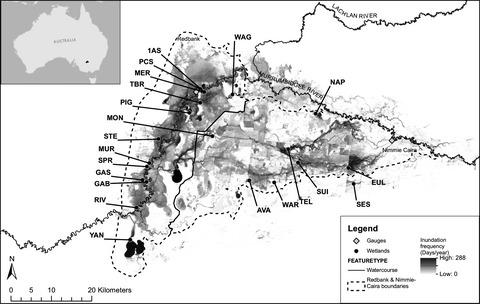当前位置:
X-MOL 学术
›
Austral Ecol.
›
论文详情
Our official English website, www.x-mol.net, welcomes your
feedback! (Note: you will need to create a separate account there.)
Amphibian occurrence and abundance patterns across a modified floodplain ecosystem
Austral Ecology ( IF 1.6 ) Pub Date : 2021-07-20 , DOI: 10.1111/aec.13084 Michelle E. Littlefair 1 , Dale G. Nimmo 1 , Joanne F. Ocock 2, 3 , Damian R. Michael 1 , Skye Wassens 1
Austral Ecology ( IF 1.6 ) Pub Date : 2021-07-20 , DOI: 10.1111/aec.13084 Michelle E. Littlefair 1 , Dale G. Nimmo 1 , Joanne F. Ocock 2, 3 , Damian R. Michael 1 , Skye Wassens 1
Affiliation

|
Amphibian populations have experienced unprecedented decline over the past few decades. River regulation, water diversions and reductions in the frequency of reconnections between rivers and floodplains have contributed to decreased floodplain inundation and overall wetland degradation, contributing to regional declines in amphibians. Hydrological modifications coupled with invasive exotic fish also have had a significant impact on inland floodplain frog communities. Using an eight-year study of 21 wetlands across a nationally important inland floodplain system, we quantified occurrence and abundance patterns in six frog species (adults and tadpoles) to a range of landscape-scale and site-scale hydrological and vegetation-related variables. Occurrence and abundance models for adult frogs and tadpoles were characterised by different suites of predictor variables and effect directions for each species. The occurrence of some frog species, such as the inland banjo frog (Limnodynastes interioris), was negatively related to distance to the main river and area of inundation, whereas the abundance of most species was positively related to mean daily discharge. Tadpoles of species such as the plains froglet (Crinia parinsignifera) had contrasting relationships to introduced common carp (Cyprinus carpio) and eastern gambusia (Gambusia holbrooki). Our findings suggest factors that lead to a particular species occurring at a wetland may differ from those that make them abundant once conditions necessary for occurrence have been met. Thus, management interventions to improve amphibian diversity across inland floodplain systems will need to consider watering actions that benefit a range of frog species, particularly endangered species, across their developmental stages.
中文翻译:

修改后的洪泛区生态系统中的两栖动物出现和丰度模式
在过去的几十年里,两栖动物的数量经历了前所未有的下降。河流调节、调水和减少河流与洪泛区之间重新连接的频率有助于减少洪泛区淹没和整体湿地退化,导致两栖动物的区域减少。水文变化加上外来入侵鱼类也对内陆泛滥平原青蛙群落产生了重大影响。通过对全国重要的内陆漫滩系统中的 21 个湿地进行为期八年的研究,我们将六种蛙类(成虫和蝌蚪)的发生和丰度模式量化为一系列景观尺度和场地尺度的水文和植被相关变量。成年青蛙和蝌蚪的出现和丰度模型的特点是每个物种的预测变量和影响方向不同。一些蛙类的出现,如内陆班卓蛙(Limnodynastes internalis ),与到主要河流的距离和淹没面积呈负相关,而大多数物种的丰度与平均每日流量呈正相关。诸如平原蛙 ( Crinia parinsignifera )等物种的蝌蚪与引进的鲤鱼 ( Cyprinus carpio ) 和东鲇 ( Gambusia holbrooki ) 有对比关系。)。我们的研究结果表明,导致特定物种出现在湿地的因素可能与一旦满足发生所需的条件后使它们丰富的因素不同。因此,改善内陆洪泛区系统两栖动物多样性的管理干预措施将需要考虑浇水行动,使一系列青蛙物种,尤其是濒危物种,在其整个发育阶段受益。
更新日期:2021-07-20
中文翻译:

修改后的洪泛区生态系统中的两栖动物出现和丰度模式
在过去的几十年里,两栖动物的数量经历了前所未有的下降。河流调节、调水和减少河流与洪泛区之间重新连接的频率有助于减少洪泛区淹没和整体湿地退化,导致两栖动物的区域减少。水文变化加上外来入侵鱼类也对内陆泛滥平原青蛙群落产生了重大影响。通过对全国重要的内陆漫滩系统中的 21 个湿地进行为期八年的研究,我们将六种蛙类(成虫和蝌蚪)的发生和丰度模式量化为一系列景观尺度和场地尺度的水文和植被相关变量。成年青蛙和蝌蚪的出现和丰度模型的特点是每个物种的预测变量和影响方向不同。一些蛙类的出现,如内陆班卓蛙(Limnodynastes internalis ),与到主要河流的距离和淹没面积呈负相关,而大多数物种的丰度与平均每日流量呈正相关。诸如平原蛙 ( Crinia parinsignifera )等物种的蝌蚪与引进的鲤鱼 ( Cyprinus carpio ) 和东鲇 ( Gambusia holbrooki ) 有对比关系。)。我们的研究结果表明,导致特定物种出现在湿地的因素可能与一旦满足发生所需的条件后使它们丰富的因素不同。因此,改善内陆洪泛区系统两栖动物多样性的管理干预措施将需要考虑浇水行动,使一系列青蛙物种,尤其是濒危物种,在其整个发育阶段受益。










































 京公网安备 11010802027423号
京公网安备 11010802027423号